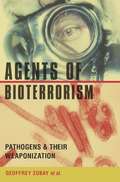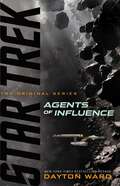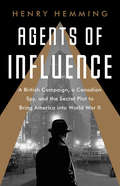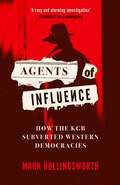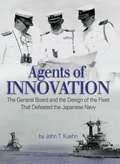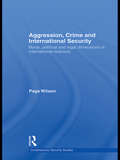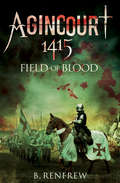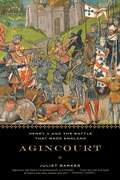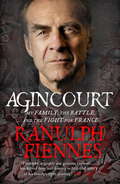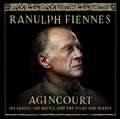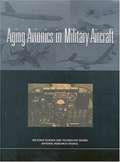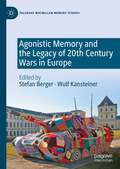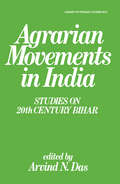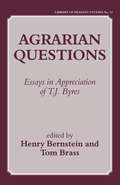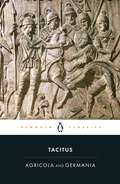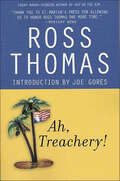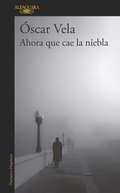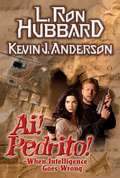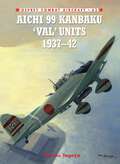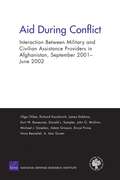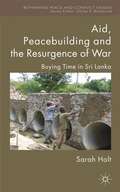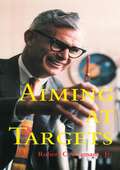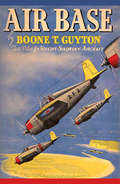- Table View
- List View
Agents of Bioterrorism: Pathogens and Their Weaponization
by Geoffrey ZubayThis new work offers a clear and thorough account of the threats posed by bioterrorism from the perspective of biologists. The authors examine thirteen disease-causing agents, including those responsible for anthrax, the plague, smallpox, influenza, and SARS. Each chapter considers a particular pathogen from the standpoint of its history, molecular biology, pathology, clinical presentation, diagnosis, weaponization, and defenses. The book also examines strategies for making vaccines and protecting the population in a bioterror attack.
Agents of Influence (Star Trek: The Original Series)
by Dayton WardAn epic new Star Trek saga by New York Times bestselling author Dayton Ward set during the original Five-Year Mission!For years, Starfleet Intelligence agents have carried out undercover assignments deep within the Klingon Empire. Surgically altered and rigorously trained in Klingon culture, they operate in plain sight and without any direct support, while collecting information and infiltrating the highest levels of imperial power. Their actions have given Starfleet valuable insight into the inner workings of Klingon government and its relentless military apparatus. After three of Starfleet&’s longest serving agents fear exposure, they initiate emergency extraction procedures. Their planned rendezvous with the USS Endeavour goes awry, threatening to reveal their activities and the damaging intelligence they&’ve collected during their mission. Tasked by Starfleet to salvage the botched rescue attempt, Captain James T. Kirk and the crew of the USS Enterprise must discover the truth behind a secret weapons experiment while avoiding an interstellar incident with the potential to ignite a new war between the Federation and one of its oldest adversaries.
Agents of Influence: A British Campaign, a Canadian Spy, and the Secret Plot to Bring America into World War II
by Henry HemmingThe astonishing story of the British spies who set out to draw America into World War IIAs World War II raged into its second year, Britain sought a powerful ally to join its cause-but the American public was sharply divided on the subject. Canadian-born MI6 officer William Stephenson, with his knowledge and influence in North America, was chosen to change their minds by any means necessary.In this extraordinary tale of foreign influence on American shores, Henry Hemming shows how Stephenson came to New York--hiring Canadian staffers to keep his operations secret--and flooded the American market with propaganda supporting Franklin Roosevelt and decrying Nazism. His chief opponent was Charles Lindbergh, an insurgent populist who campaigned under the slogan "America First" and had no interest in the war. This set up a shadow duel between Lindbergh and Stephenson, each trying to turn public opinion his way, with the lives of millions potentially on the line.
Agents of Influence: How the KGB Subverted Western Democracies
by Mark HollingsworthThere&’s no such thing as a former KGB man. Agents of Influence reveals the secret history of an intelligence agency gone out of control, accountable to no one but itself and intent on subverting Western politics on a near-inconceivable scale. In 1985, 1,300 KGB officers were stationed in the USA. The FBI only had 350 counter-intelligence officers. Since the early days of the Cold War, the KGB seduced parliamentarians and diplomats, infiltrated the highest echelons of the Civil Service, and planted fake news in papers across the world. More disturbingly, it never stopped. Putin is a KGB man through and through. Journalist Mark Hollingworth reveals how disinformation, kompromat and secret surveillance continue to play key roles in Russia&’s war with Ukraine. It seems frighteningly easy to destabilise Western democracy.
Agents of Innovation
by John T. KuehnThe author examines the influence of the General Board of the U.S. Navy as an agent of innovation in the years between the world wars. A formal body established by the secretary of the Navy, the General Board served as the organizational nexus for the interaction between fleet design and the naval limitations imposed on the Navy by treaty. Particularly important, Kuehn argues, was the Board's role in implementing the Washington Naval Treaty, which limited naval armaments after 1922. Kuehn explains that the leadership of the Navy at large and the General Board in particular felt themselves especially constrained by Article XIX of the Washington Naval Treaty, which implemented a status quo on naval fortifications in the western Pacific.
Aggression, Crime and International Security: Moral, Political and Legal Dimensions of International Relations (Contemporary Security Studies)
by Page WilsonAggression, Crime and International Security examines the concept of aggression in international relations and how it has been dealt with by international law and collective security organisations. This book analyses the evolution of the concept of aggression in international relations from World War I to the post-Rome Statute era. It charts the emergence of two competing visions of this notion: on the one hand, as a triggering mechanism for collective security enforcement among states, and, on the other, as an international crime giving rise to individual responsibility. The author argues that despite certain contemporary international trends suggesting a shift away from traditional, state-centric power structures towards a more cosmopolitan, globalized polity, the history of the concept of aggression demonstrates just how far away this is in reality. By examining aggression in theory and practice at the League of Nations, the Nuremberg and Tokyo Trials, the United Nations, the conference establishing the Rome Statute, and beyond, the book reveals the recurring moral, political and legal challenges this concept poses - challenges which continue to be at the forefront of thinking about international relations today. This book will be of great interest to students of International Law, War Crimes, International Relations and Security Studies.
Agincourt, 1415: Field of Blood
by B. RenfrewA gripping fictionalized account of the landmark battle that turned the tide of history. On October 25, 1415, a trapped and vastly outnumbered force of exhausted and demoralized English archers and men-at-arms faced a colossal army of French knights on a desolate field in northern France. What took place that day became one of the greatest moments of the Hundred Years&’ War and English history. Based on chronicles of the times, Agincourt 1415: Field of Blood is a dramatic, minute-by-minute retelling of the battle as seen through the eyes of the commanders and soldiers on both sides. This is a brutal, bloody, and captivating retelling of a major British victory written by a Pulitzer Prize finalist. This work sets a new standard for historical fiction. &“If you look for a book to read on a chair next to the fireplace holding a glass of whiskey, this book is highly recommendable.&” —Historic Battlefield Tours
Agincourt: Henry V and the Battle That Made England
by Juliet BarkerWaged almost six centuries ago, the Battle of Agincourt still captivates. It is the classic underdog story, and generations have wondered how the English--outmanned by the French six to one--could have succeeded so bravely and brilliantly. Drawing on a wide range of sources, Juliet Barker paints a gripping narrative of the October 1415 clash between the outnumbered English archers and the heavily armored French knights. Populated with chivalrous heroes, dastardly spies, and a ferocious and bold king, AGINCOURT is as earthshaking as its subject--and confirms Juliet Barker's status as both a historian and a storyteller of the first rank.
Agincourt: My Family, the Battle and the Fight for France
by Ranulph Fiennes25 October 2015 was the 600th anniversary of the battle of Agincourt - a hugely resonant event in English (and French) history. Sir Ranulph Fiennes casts new light on this epic event, revealing that three of his own ancestors fought in the battle for Henry V, and at least one for the French. This is a unique perspective on Agincourt from a trained and decorated soldier. Ran reveals the truth behind the myths and legends of the battle. He tells how after the battle Henry V entertained his senior commanders to dinner, where they were waited on by captured French knights. There is the story of Sir Piers Legge of Lyme Hall, who lay wounded in the mud while his mastiff dog fought off the French men-at-arms. Then there is the legend that the French intended to cut off the first and second right hand fingers of every captured archer, to prevent him from using his bow. The archers raised those two fingers to the advancing French as a gesture of defiance. In this gripping study Sir Ranulph Fiennes brings back to life these stories and more, including those of his own ancestors, in a celebration of a historical event integral to English identity.Fiennes, arguably our greatest explorer...has delved deep into history to tell the story of his family's epic journey. - The Times
Agincourt: My Family, the Battle and the Fight for France
by Ranulph Fiennes25 October 2015 was the 600th anniversary of the battle of Agincourt - a hugely resonant event in English (and French) history. Sir Ranulph Fiennes casts new light on this epic event, revealing that three of his own ancestors fought in the battle for Henry V, and at least one for the French. This is a unique perspective on Agincourt from a trained and decorated soldier. Ran reveals the truth behind the myths and legends of the battle. He tells how after the battle Henry V entertained his senior commanders to dinner, where they were waited on by captured French knights. There is the story of Sir Piers Legge of Lyme Hall, who lay wounded in the mud while his mastiff dog fought off the French men-at-arms. Then there is the legend that the French intended to cut off the first and second right hand fingers of every captured archer, to prevent him from using his bow. The archers raised those two fingers to the advancing French as a gesture of defiance. In this gripping study Sir Ranulph Fiennes brings back to life these stories and more, including those of his own ancestors, in a celebration of a historical event integral to English identity.Fiennes, arguably our greatest explorer...has delved deep into history to tell the story of his family's epic journey. - The Times
Agincourt: My Family, the Battle and the Fight for France
by Ranulph Fiennes25 October 2015 is the 600th anniversary of the battle of Agincourt - a hugely resonant event in English (and French) history. Sir Ranulph Fiennes casts new light on this epic event, revealing that three of his own ancestors fought in the battle for Henry V, and at least one for the French. This is a unique perspective on Agincourt from a trained and decorated soldier. Ran reveals the truth behind the myths and legends of the battle. He tells how after the battle Henry V entertained his senior commanders to dinner, where they were waited on by captured French knights. There is the story of Sir Piers Legge of Lyme Hall, who lay wounded in the mud while his mastiff dog fought off the French men-at-arms. Then there is the legend that the French intended to cut off the first and second right hand fingers of every captured archer, to prevent him from using his bow. The archers raised those two fingers to the advancing French as a gesture of defiance. In this gripping new study Sir Ranulph Fiennes brings back to life these stories and more, including those of his own ancestors, in a celebration of a historical event integral to English identity.(P)2014 Hodder & Stoughton
Aging Avionics in Military Aircraft
by National Research Council Air Force Science Technology BoardA summary of Aging Avionics in Military Aircraft
Agonistic Memory and the Legacy of 20th Century Wars in Europe (Palgrave Macmillan Memory Studies)
by Stefan Berger Wulf KansteinerThis book discusses the merits of the theory of agonistic memory in relation to the memory of war. After explaining the theory in detail it provides two case studies, one on war museums in contemporary Europe and one on mass graves exhumations, which both focus on analyzing to what extent these memory sites produce different regimes of memory. Furthermore, the book provides insights into the making of an agonistic exhibition at the Ruhr Museum in Essen, Germany. It also analyses audience reaction to a theatre play scripted and performed by the Spanish theatre company Micomicion that was supposed to put agonism on stage. There is also an analysis of a Massive Open Online Course (MOOC) designed and delivered on the theory of agonistic memory and its impact on the memory of war. Finally, the book provides a personal review of the history, problems and accomplishments of the theory of agonistic memory by the two editors of the volume.
Agrarian Movements in India: Studies on 20th Century Bihar
by Arvind N. DasFirst published in 1982. Routledge is an imprint of Taylor & Francis, an informa company.
Agrarian Questions: Essays in Appreciation of T. J. Byres
by Tom Brass Henry BernsteinThis collection celebrates T.J. Byres' seminal contributions to the political economy of the agrarian question. Uniting the various themes is the demonstration of the continuing relevance of a critical, historical and comparative materialist analysis of agrarian question.
Agricola and Germania
by TacitusThe Agricola is both a portrait of Julius Agricola - the most famous governor of Roman Britain and Tacitus' well-loved and respected father-in-law - and the first detailed account of Britain that has come down to us. It offers fascinating descriptions of the geography, climate and peoples of the country, and a succinct account of the early stages of the Roman occupation, nearly fatally undermined by Boudicca's revolt in AD 61 but consolidated by campaigns that took Agricola as far as Anglesey and northern Scotland. The warlike German tribes are the focus of Tacitus' attention in the Germania, which, like the Agricola, often compares the behaviour of 'barbarian' peoples favourably with the decadence and corruption of Imperial Rome.
Ah, Treachery!
by Ross ThomasAh, Treachery!, the last novel Thomas wrote before his death, tells the story of one Captain Edd "Twodees" Partain, drummed out of the Army and hounded by rumors of his involvement in a secret operation in El Salvador. Twodees gets hired on to help a fundraiser for the "Little Rock folks" recover funds that were stolen from an illicit stash used to smooth over problems and pay off hush money. Meanwhile, Partain is involved in a storefront operation called VOMIT (Victims of Military Intelligence Treachery) trying to defend former intelligence operatives such as Partain from those who are trying to cover up the past permanently.
Ahora que cae la niebla
by Oscar VelaLa asombrosa historia de Manuel Antonio Muñoz Borrero, cónsul ecuatoriano en Estocolmo, que durante la Segunda Guerra Mundial salvó la vida de cientos de familias judías. Ahora que cae la niebla es la biografía novelada de Manuel Antonio Muñoz Borrero, cónsul de Ecuador en Estocolmo entre 1935 y 1942; un hombre que decidió guardar un secreto hasta la muerte, y que recientemente se convirtió en héroe. Con una combinación sorprendente de ficción y de realidad, Óscar Vela consigue trazar el retrato de un personaje que desde su posición privilegiada de diplomático se la jugó para salvar a cientos de familias judías durante la Segunda Guerra Mundial. El suspenso, la aventura y una conmovedora historia de amor, son los motores de esta narración de guerra, que por encima de todo pone en evidencia la valentía de un hombre que representa a todos aquellos que hasta hoy siguen arriesgando su vida por la libertad de los demás.
Ai! Pedrito! When Intelligence Goes Wrong
by Kevin J. Anderson L. Ron HubbardA rollicking and unpredictable adventure through the world of spies and double agents, lovers and enemies (often one and same). It has been said that somewhere in the world you have an exact double. This rocket-ride of a novel ignites with the sudden cry of "Ai! Pedrito!", as Naval Lieutenant Tom Smith discovers that his exact look-alike is the notorious South American revolutionary and spy, Pedrito Miraflores. Inspired by a real incident in the life of L. Ron Hubbard, "Ai! Pedrito!" is a fun-to-read, compelling novel of what can sometimes happen when intelligence goes wrong. "All the fast pacing of James Bond and the adventure of Indiana Jones." --Mystery Scene
Aichi 99 Kanbaku 'Val' Units
by Jim Laurier Osamu TagayaThe Aichi Type 99 Carrier Bomber (D3A) - code named 'Val' by Allied intelligence - was the mainstay of the Imperial Japanese Navy's carrier dive-bomber force from 1941 to 1943. It sank more Allied warship tonnage than any other Axis aircraft during World War II (1939-1945). While the Val's participation in the major carrier battles has been widely covered in other English language sources, details of its operations have received scant attention in English. This book explores the Val's combat operations. Colour illustrations and photographs complement the development of dive-bombing methods in the IJN.
Aid During Conflict: Interaction Between Military and Civilian Assistance Providers in Afghanistan, September 2001-June 2002
by Olga Oliker James Dobbins Kurt W. Basseuner Donald L. Sampler Richard KauzlarichDescription and evaluation of relief, reconstruction, humanitarian, and humanitarian-type aid efforts in Afghanistan during the most intense phase of military operations, from September 2001 to June 2002. The efforts were generally successful, but there were serious coordination problems among the various civilian and military aid providers. Critical issues, both positive and negative, are identified, and a list of recommendations is provided for policymakers, implementers, and aid providers, based on lessons learned.
Aid for Elites
by Mark MoyarCurrent foreign aid programs are failing because they are based upon flawed assumptions about how countries develop. They attempt to achieve development without first achieving good governance and security, which are essential prerequisites for sustainable development. In focusing on the poorer members of society, they neglect the elites upon whose leadership the quality of governance and security depends. By downplaying the relevance of cultural factors to development, they avoid altering cultural characteristics that account for most of the weaknesses of elites in poor nations. Drawing on a wealth of examples from around the world, the author shows that foreign aid can be made much more effective by focusing it on human capital development. Training, education, and other forms of assistance can confer both skills and cultural attributes on current and future leaders, especially those responsible for security and governance.
Aid, Peacebuilding and the Resurgence of War
by Sarah HoltAs one of South Asia's oldest democracies Sri Lanka is a critical case to examine the limits of a liberal peace, peacebuilding and external engagement in the settlement of civil wars. Based on nine years of research, and more than 100 interviews with those affected by the war, NGOs, and local and international elites engaged in the peace process.
Aiming at Targets: The Autobiography of Robert C. Seamans Jr.
by Roger C. Seamans Jr.An essential volume in the NASA History Series by Robert C. Seamans, Jr., the Associate Administrator of NASA during the Apollo program. A stirring insider’s account of NASA and the manned space program at the highest levels. Relationships with the Department of Defense, the Apollo 204 fire, the assassination of President Kennedy, and more.Aiming at Targets is a series of fascinating topical vignettes covering the author’s professional life. Taken together, like broad brushstrokes in an impressionist painting, they give a better picture of Bob Seamans and his work than a detailed recitation of facts and dates could hope to do. This is a cheerful account of an interesting and successful career. The book is full of good stories, with many memorable characters. Like the proverbial sundial, it counts the sunny hours.
Air Base
by Boone GuytonAir Base, first published in 1941, by aviator Boone Guyton, is a fascinating look at the U.S. Navy's flying fleet shortly before Pearl Harbor and America's entry into the Second World War. In a style ranging from amusing to tragic and harrowing, Guyton describes his experiences as a Navy flyer. Following a year of flight-training at Pensacola, Guyton is based in San Diego with a carrier squadron aboard the Lexington and Saratoga. He describes the training cruises of the ship, the patrol flights, dive bombers, and war games, providing insight into the prewar Navy air force. Included are 8 pages of photographs. Following his naval service, Boone Guyton (1913-1996) worked as a test pilot in France until 1940. He returned to the U.S. and continued his work as a test pilot for Vought with the F4 Corsair. Following the war, Guyton settled in Connecticut and continued working as an executive for several aviation companies.
